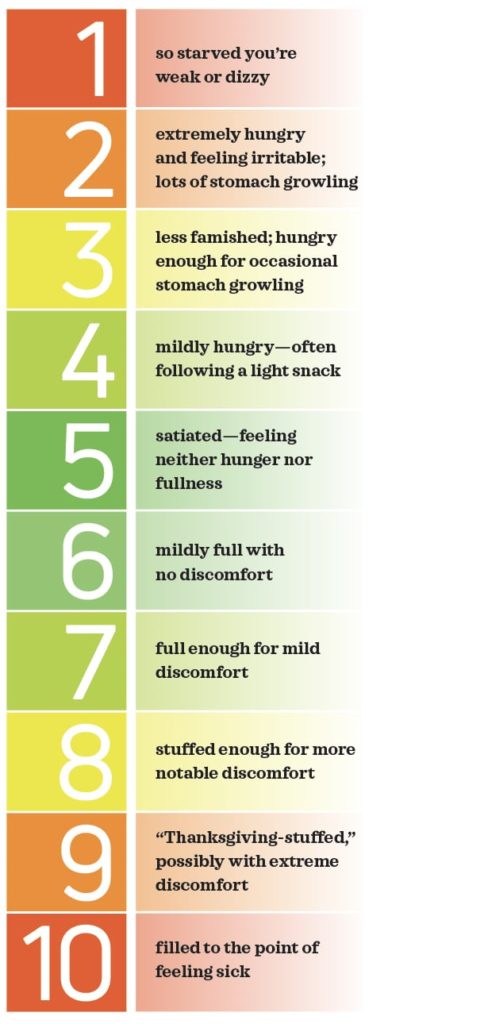Handling the Holidays With the Hunger Scale
Use the hunger scale for healthier eating habits this season.

Do you love the fall holidays but have trouble coping with all of the extra opportunities to eat high-fat and high sugar food? Learn about using the hunger scale for intuitive eating, a strategy that can help you manage your holiday eating—and give you something to be thankful for!
Cassandra Padgett, MS, health educator, ACE-certified health coach, Precision Nutrition Level 1 coach, and contributing author for ACE and IDEA, explains intuitive eating and shares how using a hunger scale can help.
What Is Intuitive Eating?
Intuitive eating means consuming food when hungry, stopping when full and not restricting certain types of foods. Did you know that it is associated with lower body mass index, better psychological health, and improved dietary intake and eating behaviors (Van Dyke & Drinkwater 2014)? While eating when hungry and stopping when full might seem like common sense, intuitive eating is challenging to put into practice. Busy lifestyles disrupt consumption patterns. Emotions like sadness, boredom and anxiety encourage people to eat when they’re not hungry.
The Hunger Scale

The hunger scale (below), commonly used in intuitive eating, is a useful response to these challenges because it helps you rediscover your body’s natural hunger and fullness cues. That leads to more intuitive eating.
The goal is to stay in the middle, or the green portion, of the scale—starting to eat at 3–4 and stopping at 5–6. Avoid the ravenous 1–2 region, where you’re more likely to overeat. Conversely, you should stop short of the “Thanksgiving-stuffed” discomfort of 9–10. Routinely overeating to extremes makes it more difficult to recognize feelings of fullness in the future.
Here’s how you can put the hunger scale to work:
- Before eating, ask, “Am I hungry?” This pause will help you identify if you are eating for hunger or for another reason, like sadness or stress. If you answer yes, you should choose a matching number on the scale. If you say no, you can identify the eating trigger and try to redirect or minimize it.
- Eat at a table, with family or friends, and without “devices.” Eliminating distractions supports mindful eating.
- Slow down. It can take 20 minutes to feel full after eating. Start with small portions, eat slowly and pause before getting seconds. Try putting your fork down between bites, chewing more slowly and engaging in conversation during meals.
- Keep healthy snacks on hand to help you avoid extreme hunger.
Make Sure the Calories Are “Worth It”
In addition to the hunger scale, you can also use the next few tips. As you know, it’s easy to overindulge when special holiday desserts are everywhere during December. The key is to devise a plan to eat dessert while maintaining a healthy eating plan overall.
Try savoring the foods you love—in small portions—but avoid less-
satisfying sweets and snacks. Before eating a not-so-healthy food, you can ask yourself, “Is this worth it?” You may decide you do not enjoy eating the food, so the calories are not worth it. This tip is especially useful at parties where that food is overabundant!
Add More Vegetables and Fruits
Another strategy is to remember to consume fruits and vegetables—even during the holidays! Their high fiber content means greater satiety, and they are also low in calories, have no fat or sodium, and can reduce the risks of type 2 diabetes, heart disease and stroke (Boeing et al. 2012).
Practice these tips for eating more fruits and vegetables:
- Chop after you shop. After grocery shopping, spend 15 minutes prepping your veggies and fruits. You are more likely to eat food that is ready to go.
- Buy prechopped produce. It is easy to buy prechopped melons, berries, mango, pineapple, salad mix, veggie trays, spiralized or riced veggies, and minced onions and peppers at most grocery stores.
- Mix fruits and veggies into foods you already eat. For example, add fruit to yogurt, oatmeal or cottage cheese. Add vegetables to sandwiches, eggs, rice, soups, etc.
See also: Using the Hunger Scale
References
Boeing, H., et al. 2012. Critical review: Vegetables and fruit in the prevention of chronic diseases. European Journal of Nutrition, 51 (6), 637–63.
Van Dyke, N., & Drinkwater, E.J. 2014. Relationships between intuitive eating and health indicators: Literature review. Public Health Nutrition, 17 (8), 1757–66.





